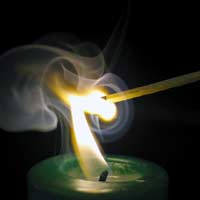
Damage from the effects of heat, smoke and soot can be severe and devastating on clothes, furniture, carpets, upholstery and walls. However, knowledge of a few good stain removal techniques can help you salvage as much as possible.
What Causes Smoke and Soot Stains?
Stains from smoke and soot are caused by carbon particles and usually result as a combination of a local source of carbon (eg. a fireplace) and air movement that causes the carbon particles to spread through the house and through fibres. Houses near busy roads, train or aeroplane routes can be particularly affected by exhaust fumes from the vehicles and other common sources are leaky furnaces, gas ranges, fireplaces and cigarette smoke. Surprisingly, the frequent use of candles in the house can also cause substantial soot staining, with certain types of candles (eg. made of low quality paraffin wax or using oils for scent) producing more soot than others. Beeswax candles are a good choice if you want to avoid soot stains. Carpets are especially susceptible to soot staining, as the fibres act as a filter for airborne carbon particles – thus over time, the carpet will darken in colour.
How Do I Remove Soot Stains From Walls?
These often accompany candles and can leave unsightly marks which ruin your interior décor. First use a vacuum attachment to remove as much loose carbon as possible,. Then rub the area with a dry sponge or a commercially available “soot sponge” – this is chemically treated to absorb soot and dirt into its pores. Finally wipe the wall with a solution of 1 Tbsp tri-sodium phosphate (TSP) diluted in about 1 gallon of warm water – and then rinse thoroughly. In some cases, this treatment will remove some paint together with the stain – in this case, you may need to prime the area and repaint. Note: just painting over the area without removing the stain will not work as the stain will likely “bleed through” the new paint within a few weeks or months.
What About Soot Stains in Clothes?
If the fabric is washable, soak the clothes overnight in a solution made up of 1 cup of automatic dishwasher detergent dissolved in 8 pints of water. Then wash as normal. If the fabric can be bleached, add some chlorine bleach to the soaking solution and soak for at least 30mins before washing as per instructions. If the fabric is not washable or delicate, it is best to seek professional help.
Soot Spills
If soot has spilled onto surfaces – such as from a fireplace – your first step is to vacuum or sweep up as much as possible. Make sure you wear old clothes, rubber gloves, a head covering (such as a cap), disposable paper dust mask and safety goggles. Be very careful not to rub as the black pigment in the carbon will smear and spread everywhere. Next, use the “soot sponge”, only switching to a clean part of the sponge when each area is already saturated with dirt. This is a dry treatment so do not ever wet the sponge as this will destroy its special chemical properties. Follow this by wiping surfaces with a warm, mild solution of the tri-sodium phosphate solution, then rinse with water and wipe dry.
When it’s Really Bad
If the smoke staining is severe – such as after a fire – it may need professional cleaning as it will become embedded in any porous surface. Some household insurance polices may cover the costs of a professional smoke removal service, as well as possibly the cost of dry cleaning for clothing, curtains, upholstery and carpets.
One of the problems with smoke is the lingering smell – this can be tackled by placing several containers of activated charcoal or wine vinegar around the house as these can help absorb odours.
Remember
Always plan your stain removal process when dealing with soot and take your time. Soot can stain very quickly if it is liquefied through liquid chemical removal (in fact, one of the most permanent types of dye, India ink, is simply carbon black mixed in a solvent medium) – so take great care that you do not inadvertently create a bigger staining problem than you started with!